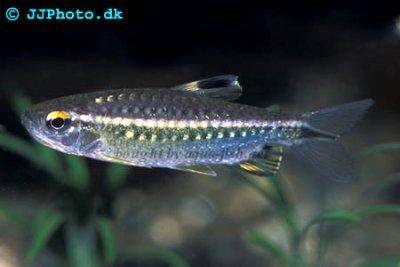Red eyed characin - Arnoldichthys spilopterus
Scientific name: Arnoldichthys spilopterus
Common name: Red eyed characin
Family: Alestidae
Usual size in fish tanks: 6 - 7 cm (2.36 - 2.76 inch)
014
Recommended pH range for the species: 6 - 8
Recommended water hardness (dGH): 5 - 19°N (89.29 - 339.29ppm)
0°C 32°F30°C 86°F
Recommended temperature: 24 - 26 °C (75.2 - 78.8°F)
The way how these fish reproduce: Spawning
Where the species comes from: Africa
Temperament to its own species: peaceful
Temperament toward other fish species: peaceful
Usual place in the tank: Top levels
Food and Feeding
Red-Eyed Characins are versatile feeders and will accept a wide range of foods. For a balanced staple diet, high-quality flake food is recommended. To keep them vibrant and healthy, supplement their diet with live or frozen treats such as bloodworms, brine shrimp, and daphnia. Offering these treats 2-3 times a week will ensure they receive the necessary nutrients and maintain their striking coloration. Occasionally, include vegetable-based foods like spirulina or blanched greens to mimic their natural diet and improve their overall health.
Origin
Red-Eyed Characins are native to West Africa, specifically found in the Lower Niger and Ogun Rivers in Nigeria. They inhabit slow-moving or still waters, such as riverine floodplains and swamps, where they thrive among dense aquatic vegetation. The natural environment of these fish features a warm climate with soft, slightly acidic to neutral water, which should be replicated in the aquarium for optimal health.
Sexing
Males will have a yellow or orange anal fin with five dark bands and a dark edging. The females will have dark spots on the anal fin.
Breeding
Breeding Red-Eyed Characins is relatively straightforward. To encourage spawning, provide a well-planted tank with a mix of fine-leaved and floating plants where the female can scatter her eggs. Before introducing the fish to the breeding tank, condition them with a diet rich in live foods for a couple of weeks. After spawning, remove the parents to prevent them from eating the eggs. The eggs typically hatch within 24-30 hours, and the fry will become free-swimming a few days later. Initially, feed the fry infusoria or finely powdered fry food, gradually transitioning to small live foods as they grow.
Lifespan
The expected life span for Arnoldichthys spilopterus is 5-10 years.
Short Description
Arnoldichthys spilopterus, commonly known as the Red-Eyed Characin, are lively and adaptable fish ideal for community aquariums. They should be kept in schools of at least 10 individuals to ensure they feel secure and exhibit natural behaviors. While they appreciate a well-planted tank, it is essential to leave open swimming areas at the front to accommodate their active nature. Their vibrant red eyes and dynamic schooling behavior make them an attractive addition to any aquarium setup.
Pictures
Images provided by jjphoto.dk and used with permission from aqua-fish.net.





 Yellowtail
Yellowtail  African
African  Longfin
Longfin  Congo
Congo